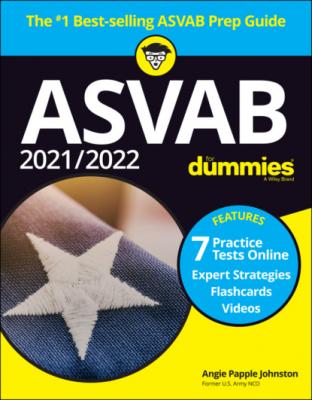2021 / 2022 ASVAB For Dummies. Angie Papple Johnston
Читать онлайн.| Название | 2021 / 2022 ASVAB For Dummies |
|---|---|
| Автор произведения | Angie Papple Johnston |
| Жанр | Учебная литература |
| Серия | |
| Издательство | Учебная литература |
| Год выпуска | 0 |
| isbn | 9781119784197 |
When You Don’t Know an Answer: Guessing Smart
On the ASVAB, guessing is sometimes okay. Guessing can help you on the paper-and-pencil version because of how the test is scored. Here’s how the point system breaks down:
If you choose the correct answer, you get one point (or more, depending on how the question is weighted).
If you don’t answer a question, you get nada.
If you guess on a question and get the question wrong, you get nada — no worrying about losing points or getting any sort of penalty!
The ASVAB’s computer system rarely has to penalize a test-taker. On average, the computerized test takes about two hours to complete, and most people have enough time to finish (or at least come very close to finishing) the test.
Don’t eliminate an answer based on how frequently that answer comes up. For example, if Choice (B) has been the correct answer for the last five questions, don’t assume that it must be the wrong answer for the question you’re on just because that would make it six in a row.
An answer that has always, all, everyone, never, none, or no one is usually incorrect.
The longer the answer, the more likely that it’s the correct answer. The test-makers have to get all those qualifiers in there so you can’t find an example to contradict the correct answer. If you see phrases like “in many cases” or “frequently,” that’s often a clue that the test-makers are trying to make the answer most correct.
If two choices are very similar in meaning, neither of them is probably the correct choice. On the other hand, if two answer options contradict each other, one of them is usually correct.
In each of the chapters in Parts 3, 4, and 5, you find more hints for making educated guesses that are specific to those topics.
Studying and Practicing for the ASVAB
The practice tests that come with this book are valuable study aids. Before you begin studying, take one of the tests. Try to duplicate the testing environment — take the entire exam at one time, time yourself, and don’t allow interruptions.
Get a sense of how long it takes you to complete each subtest so you know how much time you have to spend on educated guessing. After you complete each practice test, check your answers to see where you need improvement.
Focus on the subtests that matter to you. If you have a clear interest in pursuing a career in electronics, the Electronics Information subtest should be at the top of your list to ace. Although you’ll want to make sure all your line scores are good (in case your desired job isn’t available or you want to retrain later in your career), focusing on your expertise in certain areas of interest makes you a more desirable candidate. (See Chapter 2 and Appendix A for lists of the subtests that affect your acceptance into the job areas you’re pursuing.)
Concentrate on subject areas that need improvement. It’s human nature to find yourself spending your study time on subject areas that you have an interest in or that you’re good at. If you’re a whiz at fixing cars, don’t waste your time studying for the Auto & Shop Information subtests. You’re already going to ace that part of the test, right? On the other hand, if you had a hard time in math during your high school years, you need to spend extra time brushing up on your arithmetic skills.
Be a loner. You may want to study with a partner now and then so the two of you can brainstorm answers and quiz each other, but most of your studying should be done on your own.
Try to reduce distractions. Always study in a well-lit, quiet area away from pets, loud music, and the TV.
Study in long blocks of time. Studying for an hour or two once or twice a day is much more effective than studying 15 minutes six times a day.
Schedule your study times when you are rested. Don’t try to cram studying into your schedule. Quality over quantity!
Keep study breaks short. A few minutes every hour is sufficient. Don’t ignore breaks completely, however. Studies show that taking short breaks while you study improves how well you’re able to remember information.
Practice the actual act of test-taking. Practice marking answers correctly on the answer key and time yourself to see how long it takes you to answer questions.
